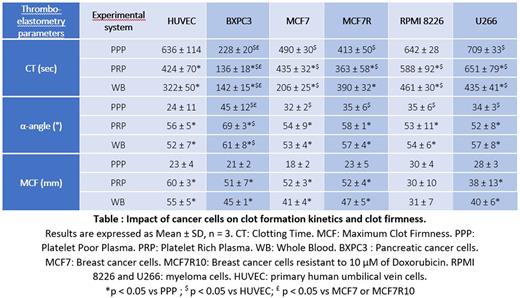Abstract
Introduction
The histological type and the aggressiveness of cancer cells as well as the acquisition of resistance to chemotherapy are significant predictors for the high risk of cancer associated thrombosis (CAT).
It is well established that cancer cells, by expressing tissue factor (TF) trigger thrombin generation. Cancer cell derived extracellular vesicles (CaCa-dEV) bearing TF, in the microenvironment, further enhance thrombin generation. The impact of cancer cells on clot formation kinetics and the qualitative characteristics of the clot has not been evaluated yet.
Aim
The present study aimed to analyze the variables which influence the kinetics and the qualitative characteristics of the clot after triggering thrombin generation by cells from pancreatic cancer (BXPC3), breast cancer (MCF7 and MCF7R10) and multiple myeloma (RPMI-8226 and U266) - associated with different risk of CAT. The impact of the resistance to chemotherapy on the clot characteristics was also studied.
Methods
Cancer cell lines (BXPC3, MCF7, MCF7R10, RPMI-8226 and U266) and primary umbilical vein endothelial cells (HUVEC) for the control experiments were used according to standardized and validated experimental procedure. Doxorubicin resistant breast cancer cells (MCF7R10) were obtained by treating native breast cancer cells (MCF7) by increasing concentrations of Doxorubicin from 5 nM to 10 µM..
Thromboelastometry, using the ROTEM® delta device (from Warfen Paris, France), was used for the study of clot formation and firmness in whole blood (WB), platelet rich and platelet poor plasma (PRP and PPP respectively) in the presence of cancer cells or HUVEC (control). A suspension of 200 μL with 105 cells was placed in each sterilized cup. Following an incubation of 4 hour, culture media was removed and 330 μL of WB, PRP or PPP were added followed by addition of 20 µM of CaCl2 (0.2 M). Clotting time (CT), α-angle and maximum clot firmness (MCF) were analyzed.
Results
In PPP, pancreatic cancer cells BXPC3 as well as chemotherapy sensitive and resistant breast cancer cells (MCF7 and MCF7R10), significantly reduced the CT. MCF7R10 cells significantly reduced the CT as compared to MCF7. In contrast, myeloma cells (RPMI8226 and U266), did not significantly affect the CT. All studied cancer cell lines significantly increased the α-angle as compared to HUVEC, with the most potent effect from BXPC3 cells. The studied cancer cell lines did not significantly affect MCF.
In PRP, BXPC3 cells significantly reduced the CT whereas MCF7 and MCF7R10 did not significantly change the CT, and myeloma cells significantly prolonged the CT as compared to HUVEC. BXPC3 cells significantly increased the α-angle as compared to the HUVEC, whereas the other studied cancer cell lines did not have any significant effect on this parameter. BXPC3, MCF7 and MCF7R10 cells did not significantly affect the MCF whereas the myeloma cells significantly decreased the MCF as compared to HUVEC.
In WB, BXPC3 and MCF7 cells significantly decreased the CT whereas MCF7R10 did not show any significant effect and the myeloma cells significantly prolonged it. The α-angle significantly increased in the presence of BXPC3 cells whereas the other cell lines did not show any significant effect on this parameter. The presence of cancer cells resulted in significant decrease of the MCF as compared to the control (HUVEC), with the most potent effect from myeloma.
In the control experiment (HUVEC), the comparison of the thromboelastometric profile of the three experimental systems (PPP, PRP and WB) showed that platelets (PRP) had a substantial impact on CT, α-angle and MCF whereas the erythrocytes (in WB) did not further modify these parameters. The same pattern of the role of platelets was observed in the presence of the studied cancer cell lines.
Discussion
The present study provides experimental evidence documenting that cancer cells impact clot formation kinetics without affecting clot firmness. The impact of cancer cells on clot formation kinetics is determined principally by the histological type. The pancreatic adenocarcinoma cells have a more pronounced effect on clot formation kinetics as compared to the breast cancer cells (sensitive or resistant to Doxorubicine). In contrast, multiple myeloma cells delay fibrin formation and polymerization and decrease the clot firmness. Platelets have a synergistic effect with cancer cells on the acceleration of the clot formation kinetics.
Disclosures
No relevant conflicts of interest to declare.
Author notes
Asterisk with author names denotes non-ASH members.


